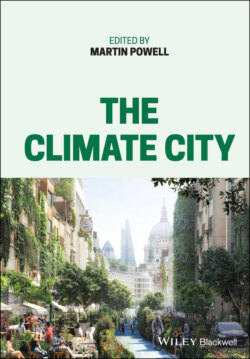Читать книгу The Climate City - Группа авторов - Страница 26
“Fully Scoped”: What Does This Mean?
ОглавлениеThere is a flexibility and power in the net-zero concept. It can apply at all levels, from the globe down through nations and states to cities, communities, households, and individuals. For the world to achieve global net-zero emissions, all relevant entities should assume responsibility for direct emissions caused by sources they directly own and control (scope 1). For cities, this has been translated as emissions created within their boundaries.
Scope 2 includes targeting GHG emissions occurring as a consequence of the use of grid-supplied electricity, heat, steam, and/or cooling within the city boundary. This is typically the electricity and heat generation from utilities that may supply the city but not be located within the boundary.
Scope 3 emissions for a city are all other GHG emissions that occur outside the city boundary as a result of activities taking place within the city boundary. This may be upstream activities such as emissions going into the production of materials consumed in the city, as well as downstream activities – emissions caused by the consumption of goods/services produced inside the city but consumed elsewhere.
If every city in the world achieves net-zero emissions for scopes 1 and 2, the urban world should expect to realize an equilibrium among sources and sinks of emissions. But this leaves no margin for error and also relies on other communities to target net-zero too. A more airtight approach would acknowledge that some entities are not targeting boldly enough and would task those that can act more assertively to take responsibility for scope 3.
C40 analysis conducted with the University of Leeds, the University of New South Wales, and Arup adopted a consumption-based approach to investigate GHG emissions of 79 cities, capturing both direct and lifecycle GHG emissions (Figure 1.4).16 This usefully captures the upstream effect of emissions arising in supply chains outside the city to meet the demand and consumption for goods and services inside the city; but from a “high-ambition” point of view it is unfortunate that it subtracts the downstream effect. It gives the city a (double) break on the emissions – both by netting out emissions created by producing goods and services inside the city that are consumed elsewhere and the emissions associated with the actual consumption (Figure 1.5).
Figure 1.4 C40 analysis: consumption-based GHG emissions of C40 cities. (Source: Consumption-based GHG emissions of C40 cities, March 2018. C40 Cities Climate Leadership Group, Inc. https://www.c40.org/researches/consumption-based-emissions.)
Figure 1.5 C40 methodology showing overlap and distinction between sector-based and consumption-based emissions. (Source: Consumption-based GHG emissions of C40 cities, March 2018. C40 Cities Climate Leadership Group, Inc. https://www.c40.org/researches/consumption-based-emissions.)
In the corporate realm, for example, Unilever’s “Wash at 30” campaign arose from internal analysis that showed most of their “full-scope” emissions were caused by consumers using their products – in this case washing with hotter water than needed to clean clothes given the detergent technology Unilever now provides. Volkswagen, bouncing back from their diesel-emissions scandal, presented at the World Climate Summit 2019 a fully comprehensive value chain analysis showing that only 15% of their targeted emissions reductions to comply with the Paris Agreement are from their vehicle production and supply chain. Meanwhile, emissions from fuel supply and customers driving vehicles accounted for 79%. For Volkswagen, assuming responsibility for scopes 1–3 is propelling a more ambitious corporate strategy (with cleaner, electric-powered cars at its heart) and in turn a beneficial impact on world CO2 emissions.
If cities are to truly lead on climate action, ideally we would define “Fully Scoped” as assuming responsibility for scopes 1, 2, and 3, upstream and downstream – sector-based and consumption-based.17 The C40 analysis shows how the consumption-based method “offers complementary insights into the drivers of GHG emission – recognizing cities as both consumers and producers of goods and services – and can help cities identify a broader range of opportunities to reduce global GHG emissions”.18
In addition to “all scopes”, “Fully Scoped” should clearly include all GHGs19 and not just carbon dioxide. We recommend that this is made explicit within the concept of “Fully Scoped”: i.e. all activities, all gases. A recent report in McKinsey Quarterly 20 shows – in Figure 1.6 – how important assuming responsibility for all gases is for any city that has significant industrial and agricultural sectors; but it also demonstrates that all cities should consider targeting all GHGs, considering waste has such a strong global warming potential outside the effects of carbon dioxide.
Figure 1.6 Anthropogenic GHG emissions per sector and type of gas. (Source: Based on Emissions databases for Global Atmospheric Research (EDGAR), 2015; FAOSTAT, 2015; IEA, 2015; Mc Kinsey Global Energy Perspective 2019; Reference case 1.5c Scenario Analysis.)
